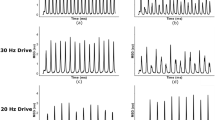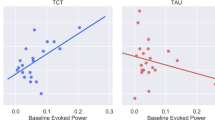Abstract
Aberrant gamma-band (30–80 Hz) oscillations may underlie cognitive deficits in schizophrenia (SZ). Gamma oscillations and their regulation by NMDA receptors can be studied via their evoked power (γEP) and phase locking (γPL) in response to auditory steady-state stimulation; these auditory steady-state responses (ASSRs) may be biomarkers for target engagement and early therapeutic effects. We previously reported that memantine, an NMDA receptor antagonist, enhanced two biomarkers of early auditory information processing: prepulse inhibition and mismatch negativity (MMN) in SZ patients and healthy subjects (HS). Here, we describe memantine effects on γEP and γPL in those subjects. SZ patients (n=18) and HS (n=14) received memantine 20 mg (p.o.) and placebo over 2 test days in a double-blind, randomized, counterbalanced, cross-over design. The ASSR paradigm (1 ms, 85 dB clicks in 250–0.5 s trains at a frequency of 40 Hz; 0.5 s inter-train interval) was used to assess γEP and γPL. SZ patients had reduced γEP and γPL; memantine enhanced γEP and γPL (p<0.025 and 0.002, respectively) in both SZ and HS. In patients, significant correlations between age and memantine effects were detected for γEP and γPL: greater memantine sensitivity on γEP and γPL were present in younger SZ patients, similar to our reported findings with MMN. Memantine acutely normalized cortical oscillatory dynamics associated with NMDA receptor dysfunction in SZ patients. Ongoing studies will clarify whether these acute changes predict beneficial clinical, neurocognitive and functional outcomes. These data support the use of gamma-band ASSR as a translational end point in pro-cognitive drug discovery and early-phase clinical trials.
Similar content being viewed by others
Log in or create a free account to read this content
Gain free access to this article, as well as selected content from this journal and more on nature.com
or
References
Bhakta SG, Chou HH, Rana B, Talledo JA, Balvaneda B, Gaddis L et al (2016). Effects of acute memantine administration on MATRICS consensus cognitive battery performance in psychosis: testing an experimental medicine strategy. Psychopharmacology 233: 2399–2410.
de Lucena D, Fernandes BS, Berk M, Dodd S, Medeiros DW, Pedrini M et al (2009). Improvement of negative and positive symptoms in treatment-refractory schizophrenia: a double-blind, randomized, placebo-controlled trial with memantine as add-on therapy to clozapine. J Clin Psychiatry 70: 1416–1423.
Featherstone RE, McMullen MF, Ward KR, Bang J, Xiao J, Siegel SJ (2015). EEG biomarkers of target engagement, therapeutic effect, and disease process. Ann N Y Acad Sci 1344: 12–26.
Ford JM, Mathalon DH (2008). Neural synchrony in schizophrenia. Schizophr Bull 34: 904–906.
Giakoumaki SG, Bitsios P, Frangou S (2006). The level of prepulse inhibition in healthy individuals may index cortical modulation of early information processing. Brain Res 1078: 168–170.
Hirano Y, Oribe N, Kanba S, Onitsuka T, Nestor PG, Spencer KM (2015). Spontaneous gamma activity in schizophrenia. JAMA Psychiatry 72: 813–821.
Hiyoshi T, Kambe D, Karasawa J-I, Chaki S (2014). Differential effects of NMDA receptor antagonists at lower and higher doses on basal gamma band oscillation power in rat cortical electroencephalograms. Neuropharmacology 85: 384–396.
Javitt DC (2012). Twenty-five years of glutamate in schizophrenia: are we there yet? Schizophr Bull 38: 911–913.
John JP, Lukose A, Manjunath S (2014). Off-label use of memantine as adjunctive treatment in schizophrenia: a retrospective case series study. Pharmacopsychiatry 47: 202–209.
Kay SR, Fiszbein A, Opler LA (1987). The positive and negative syndrome scale (PANSS) for schizophrenia. Schizophr Bull 13: 261–276.
Kirihara K, Rissling AJ, Swerdlow NR, Braff DL, Light GA (2012). Hierarchical organization of gamma and theta oscillatory dynamics in schizophrenia. Biol Psychiatry 71: 873–880.
Krivoy A, Weizman A, Laor L, Hellinger N, Zemishlany Z, Fischel T (2008). Addition of memantine to antipsychotic treatment in schizophrenia inpatients with residual symptoms: a preliminary study. Eur Neuropsychopharmacol 18: 117–121.
Lesca G, Rudolf G, Bruneau N, Lozovaya N, Labalme A, Boutry-Kryza N et al (2013). GRIN2A mutations in acquired epileptic aphasia and related childhood focal epilepsies and encephalopathies with speech and language dysfunction. Nat Genet 45: 1061–1066.
Li D, Yuan H, Ortiz-Gonzalez XR, Marsh ED, Tian L, McCormick EM et al (2016). GRIN2D recurrent de novo dominant mutation causes a severe epileptic encephalopathy treatable with NMDA receptor channel blockers. Am J Hum Genet 99: 802–816.
Lieberman JA, Papadakis K, Csernansky J, Litman R, Volavka J, Jia XD et al (2009). A randomized, placebo-controlled study of memantine as adjunctive treatment in patients with schizophrenia. Neuropsychopharmacology 34: 1322–1329.
Light GA, Hsu JL, Hsieh MH, Meyer-Gomes K, Sprock J, Swerdlow NR et al (2006). Gamma band oscillations reveal neural network cortical coherence dysfunction in schizophrenia patients. Biol Psychiatry 60: 1231–1240.
Light GA, Swerdlow NR (2014). Neurophysiological biomarkers informing the clinical neuroscience of schizophrenia: mismatch negativity and prepulse inhibition of startle. Curr Top Behav Neurosci 21: 293–314.
Light GA, Swerdlow NR (2015a). Future clinical uses of neurophysiological biomarkers to predict and monitor treatment response for schizophrenia. Ann N Y Acad Sci 1344: 105–119.
Light GA, Swerdlow NR (2015b). Bending the curve on psychosis outcomes. Lancet Psychiatry 2: 365–367.
Light GA, Swerdlow NR, Braff DL (2007). Preattentive sensory processing is associated with cognitive and psychosocial functioning in healthy adults. J Cogn Neurosci 19: 1624–1632.
Lipton SA (2006). Paradigm shift in neuroprotection by NMDA receptor blockade: memantine and beyond. Nat Rev Drug Discov 5: 160–170.
Ma J, Mufti A, Stan Leung L (2015). Effects of memantine on hippocampal long-term potentiation, gamma activity, and sensorimotor gating in freely moving rats. Neurobiol Aging 36: 2544–2554.
Matsuda Y, Kishi T, Iwata N (2013). Efficacy and safety of NMDA receptor antagonists augmentation therapy for schizophrenia: an updated meta-analysis of randomized placebo-controlled trials. J Psychiatr Res 47: 2018–2020..
Mazinani R, Nejati S, Khodaei M (2017). Effects of memantine added to risperidone on the symptoms of schizophrenia: a randomized double-blind, placebo-controlled clinical trial. Psychiatry Res 247: 291–295.
McNally JM, McCarley RW (2016). Gamma band oscillations: a key to understanding schizophrenia symptoms and neural circuit abnormalities. Curr Opin Psychiatry 29: 202–210.
O'Donnell BF, Vohs JL, Krishnan GP, Rass O, Hetrick WP, Morzorati SL (2013). The auditory steady-state response (ASSR): a translational biomarker for schizophrenia. Suppl Clin Neurophysiol 62: 101–112.
Omranifard V, Rajabi F, Mohammadian-Sichani M, Maracy M (2015). The effect of add-on memantine on global function and quality of life in schizophrenia: a randomized, double-blind, controlled, clinical trial. Adv Biomed Res 4: 211.
Paraschakis A (2014). Tackling negative symptoms of schizophrenia with memantine. Case Rep Psychiatry 2014: 384783.
Perez V, Tarasenko M, Miyakoshi M, Pianka S, Makeig S, Braff D et al. Mismatch negativity is a sensitive and predictive biomarker of perceptual learning during auditory cognitive training in schizophrenia. Neuropsychopharmacology (in press).
Phillips KG, Cotel MC, McCarthy AP, Edgar DM, Tricklebank M, O'Neill MJ et al (2012). Differential effects of NMDA antagonists on high frequency and gamma EEG oscillations in a neurodevelopmental model of schizophrenia. Neuropharmacology 62: 1359–1370.
Pierson TM, Yuan H, Marsh ED, Fuentes-Fajardo K, Adams DR, Markello T et al (2014). GRIN2A mutation and early-onset epileptic encephalopathy: personalized therapy with memantine. Ann Clin Transl Neurol 1: 190–198.
Povysheva NV, Johnson JW (2016). Effects of memantine on the excitation-inhibition balance in prefrontal cortex. Neurobiol Dis 96: 75–83.
Rackelmann S, Tarasenko M, Shiluk A, Zhang W, Bismark AW, Thomas ML et al (2016). Speech-in-Noise Perception Deficits Reflect Central Auditory Dysfunction in Schizophrenia. Proceedings Society for Neuroscience: San Diego, CA, USA.
Rezaei F, Mohammad-Karimi M, Seddighi S, Modabbernia A, Ashrafi M, Salehi B et al (2013). Memantine add-on to risperidone for treatment of negative symptoms in patients with stable schizophrenia: randomized, double-blind, placebo-controlled study. J Clin Psychopharmacol 33: 336–342.
Rissling AJ, Miyakoshi M, Sugar CA, Braff DL, Makeig SM, Light GA (2014). Cortical substrates and functional correlates of auditory deviance processing deficits in schizophrenia. Neuroimage Clin 6: 424–437.
Salisbury DF, Polizzotto NR, Nestor PG, Haigh SM, Koehler J, McCarley RW (2017). Pitch and duration mismatch negativity and premorbid intellect in the first hospitalized schizophrenia spectrum. Schizophr Bull 43: 407–416.
Sheehan DV, Lecrubier Y, Sheehan KH, Amorim P, Janavs J, Weiller E et al (1998). The Mini-International Neuropsychiatric Interview (M.I.N.I.): the development and validation of a structured diagnostic psychiatric interview for DSM-IV and ICD-10. J Clin Psychiatry 59 (Suppl 20): 22–33.
Sivarao DV, Chen P, Senapati A, Yang Y, Fernandes A, Benitex Y et al (2016). 40 Hz auditory steady-state response is a pharmacodynamic biomarker for cortical NMDA receptors. Neuropsychopharmacology 41: 2232–2240.
Sonkusare SK, Kaul CL, Ramarao P (2005). Dementia of Alzheimer's disease and other neurodegenerative disorders—memantine, a new hope. Pharmacol Res 51: 1–17.
Spencer KM, Nestor PG, Perlmutter R, Niznikiewicz MA, Klump MC, Frumin M et al (2004). Neural synchrony indexes disordered perception and cognition in schizophrenia. Proc Natl Acad Sci USA 101: 17288–17293.
Sun Y, Farzan F, Barr MS, Kirihara K, Fitzgerald PB, Light GA et al (2011). Gamma oscillations in schizophrenia: mechanisms and clinical significance. Brain Res 1413: 98–114.
Swerdlow NR (2011). Are we studying and treating schizophrenia correctly? Schizophr Res 130: 1–10.
Swerdlow NR, Bhakta S, Chou HH, Talledo JA, Balvaneda B, Light GA (2016). Memantine effects on sensorimotor gating and mismatch negativity in patients with chronic psychosis. Neuropsychopharmacology 41: 419–430.
Swerdlow NR, Light GA, Cadenhead KS, Sprock J, Hsieh MH, Braff DL (2006). Startle gating deficits in a large cohort of patients with schizophrenia: relationship to medications, symptoms, neurocognition, and level of function. Arch Gen Psychiatry 63: 1325–1335.
Swerdlow NR, van Bergeijk DP, Bergsma F, Weber E, Talledo J (2009). The effects of memantine on prepulse inhibition. Neuropsychopharmacology 34: 1854–1864.
Swerdlow NR, Tarasenko M, Bhakta SG, Talledo J, Alvarez AI, Hughes EL et al. Amphetamine enhances gains in auditory discrimination training in adult schizophrenia patients. Schizophrenia Bull (in press).
Tarasenko M, Swerdlow NR, Makeig S, Braff DL, Light GA (2014). The auditory brainstem response to complex sounds: a potential biomarker for guiding treatment of psychosis. Front Psychiatry 5: 142.
Thomas ML, Green MF, Hellemann G, Sugar CA, Tarasenko M, Calkins ME et al (2017). Modeling the cascade of deficits from early auditory information processing to psychosocial functioning in schizophrenia. JAMA Psychiatry 74: 37–46.
Thuné H, Recasens M, Uhlhaas PJ (2016). The 40-Hz auditory steady-state response in patients with schizophrenia: a meta-analysis. JAMA Psychiatry 73: 1145–1153.
Traub RD, Whittington MA, Stanford IM, Jefferys JG (1996). A mechanism for generation of long-range synchronous fast oscillations in the cortex. Nature 383: 621–624.
Veerman SRT, Schulte PFJ, Smith JD, de Haan L (2016a). Memantine augmentation in clozapine-refractory schizophrenia: a randomized double-blind, placebo-controlled crossover study. Psychol Med 46: 1909–1921.
Veerman SR, Schulte PF, Deijen JB, de Haan L (2016b). Adjunctive memantine in clozapine-treated refractory schizophrenia: an open-label 1-year extension study. Psychol Med 47: 363–375.
Zdanys K, Tampi RR (2008). A systematic review of off-label uses of memantine for psychiatric disorders. Prog Neuropsychopharmacol Biol Psychiatry 32: 1362–1374.
Acknowledgements
This work was supported by the National Institute of Mental Health (MH-059803, MH094320, and MH101072), the Brain and Behavior Research Foundation, the VISN-22 Mental Illness Research, Education, and Clinical Center (MIRECC), and the Sidney R Baer, Jr Research Foundation.
Author information
Authors and Affiliations
Corresponding author
Additional information
Supplementary Information accompanies the paper on the Neuropsychopharmacology website
PowerPoint slides
Rights and permissions
About this article
Cite this article
Light, G., Zhang, W., Joshi, Y. et al. Single-Dose Memantine Improves Cortical Oscillatory Response Dynamics in Patients with Schizophrenia. Neuropsychopharmacol. 42, 2633–2639 (2017). https://doi.org/10.1038/npp.2017.81
Received:
Revised:
Accepted:
Published:
Issue date:
DOI: https://doi.org/10.1038/npp.2017.81
This article is cited by
-
Sex differences in the lateralization of sustained electrophysiological response to 40 Hz clicks in typically developing preschoolers
Scientific Reports (2025)
-
Corticolimbic circuitry as a druggable target in schizophrenia spectrum disorders: a narrative review
Translational Psychiatry (2025)
-
Andrographolide increases adult hippocampal neurogenesis and prolongs contextual fear memory
Psychopharmacology (2025)
-
The electroencephalography protocol for the Accelerating Medicines Partnership® Schizophrenia Program: Reliability and stability of measures
Schizophrenia (2025)
-
Cortical connectomic mediations on gamma band synchronization in schizophrenia
Translational Psychiatry (2023)



